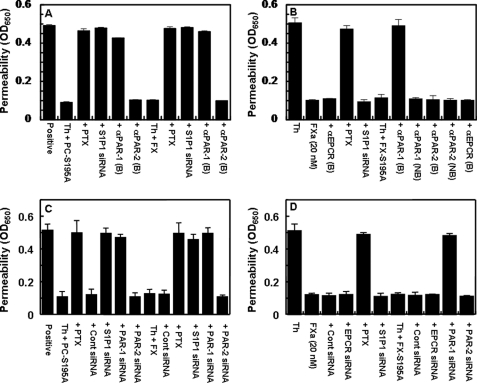FIGURE 2.
Protein C and FX switch the PAR-1-dependent signaling specificity of thrombin through the transactivation of S1P1. A, EA.hy926 cells were pretreated with buffer control or PC-S195A and FX (50 nm each, 30 min) and thrombin (2 nm, 3 h) before inducing the permeability with thrombin (5 nm, 10 min). In the presence of siRNA or PTX, cells were transiently transfected with siRNA for S1P1 (0.2 μg, 3 h) or PTX (100 ng/ml, 16 h) before treatment with zymogens. In the presence of the indicated blocking antibodies, cells were pretreated with anti-PAR-1 and anti-PAR-2 antibodies (25 μg/ml for 30 min). B, the same as A except that the signaling activity of FXa (20 nm) or thrombin (2 nm) or thrombin (2 nm) + FX-S195A (50 nm) in the absence and presence of blocking and non-blocking antibodies to the indicated receptors were compared. C and D, the same as A and B except that instead of EA.hy926 cells, primary HUVECs, and instead of blocking antibodies, siRNA specific for the receptors (EPCR, PAR-1, and PAR-2, 0.2 μg, 3 h) were used in the experiments. All results are means ± S.D. of three different experiments.

